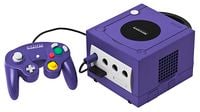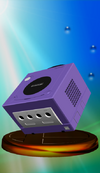Nintendo GameCube: Difference between revisions
| Line 50: | Line 50: | ||
==In competitive play== | ==In competitive play== | ||
Due to being the original hardware the game was designed for, the GameCube is the prefered system to play ''Melee'', especially in tournaments. The game has never been re-released on another system, | Due to being the original hardware the game was designed for, the GameCube is the prefered system to play ''Melee'', especially in tournaments. The game has never been re-released on another system, so players with physical copies can only use GameCube compatible systems. While the Wii can play GameCube games with a dedicated disc drive and controller ports, only the original model contains these features, making it an unreliable option. Emulators like Dolphin also exist, but they are merely recreating original hardware and possess bugs and performance issues not present on GameCube. However, the aging hardware that is becoming progressively less reliable have forced the competitive scene to consider and experiment with these alternatives before the game the love becomes unplayable, and emulation developers have made great strides in making a nearly identical experience, with software like Slippi rivaling original hardware in popularity due to ease of inserting [[mod]]s and the implementation of rollback netcode for online matches, which is not even an option on original hardware. | ||
Just like how it is possible to dump GameCube disc and memory card data onto other systems, fans savvy in computer science and engineering have found ways to make their own discs and memory cards that work on original hardware and dump data from other systems onto them. This allows mods and fan-games to be played in said original hardware, including the many based on ''Melee''. In this area, the Wii has greatly outpaced the GameCube in popularity due to possessing more industry standard hardware compared to its predecessor and the ease of defeating the console's copy protection and anti-piracy firmware to allow mods. | Just like how it is possible to dump GameCube disc and memory card data onto other systems, fans savvy in computer science and engineering have found ways to make their own discs and memory cards that work on original hardware and dump data from other systems onto them. This allows mods and fan-games to be played in said original hardware, including the many based on ''Melee''. In this area, the Wii has greatly outpaced the GameCube in popularity due to possessing more industry standard hardware compared to its predecessor and the ease of defeating the console's copy protection and anti-piracy firmware to allow mods. | ||
Revision as of 20:30, March 21, 2023
| Nintendo GameCube | |
|---|---|
 | |
| Manufacturer | Nintendo |
| Type | Video game console |
| Generation | Sixth generation |
| First available | |
| CPU | IBM PowerPC "Gekko", 486 MHz |
| GPU | ATI "Flipper", 162 MHz |
| Media | 4 cm optical disc |
| System storage | Nintendo GameCube Memory Card |
| Controller input | Nintendo Gamecube controller |
| Connectivity | Nintendo GameCube Broadband Adapter and Modem Adapter |
| Backward compatibility | Game Boy Advance |
| Predecessor | Nintendo 64 |
| Successor | Wii |
| Article on Nintendo Wiki | Nintendo GameCube |
The Nintendo GameCube (ニンテンドーゲームキューブ, Nintendo GameCube), also known as GCN or simply GameCube, is the fourth internationally released home video game console released by Nintendo in 2001. Super Smash Bros. Melee is one of its games, and its top-seller.
The original model of its successor, the Wii, is backward compatible with the Nintendo GameCube, capable of playing all of its games and accepting its controllers and Memory Cards. Various Wii games have allowed use of a GameCube controller as a way to have a more traditional way to play, including Super Smash Bros. Brawl. The control scheme in Brawl works much like it did in Melee.
General information
The Nintendo GameCube is unique in that its discs are smaller than any other game disc, utilizing a proprietary variant of the 8 cm MiniDVD. The controller features a considerably different layout from the Nintendo 64 controller. The C-buttons are replaced with a C-Stick which is identical in function, its shoulder buttons are pressure-sensitive, and sports a new binary wing grip design as opposed to the Nintendo 64 controller's ternary wing grip design, along with many other differences. It is the first Nintendo console to introduce online play, although in an extremely limited, decentralized manner unlike its competitors, the Sony PlayStation 2 and Microsoft's Xbox console. The system sold 21.74 million units worldwide, selling significantly less than the PS2, and slightly less than the Xbox, only outselling former rival Sega's Dreamcast.
In the Super Smash Bros. series
Super Smash Bros. Melee was released for the system on November 21st, 2001 in Japan, December 3rd, 2001 in North America, May 24th, 2002 in Europe, and May 31st, 2002 in Australia.
The Nintendo GameCube appears within Super Smash Bros. Melee as a trophy, with its description breaking the fourth wall. It also appears as a platform in Luigi's Target Test in Melee in the center of the stage. In addition, the background of the Trophy Hoard room in Melee contains a GameCube (with controller) along with several other gaming implements, including a Game & Watch handheld, a Game Boy and a Nintendo 64 containing a copy of the original Super Smash Bros.
Various fighters in the Super Smash Bros. series originate from games originally released for the Nintendo GameCube:
- Ike, Toon Link, and Olimar in Brawl.
- Bowser Jr. in Super Smash Bros. 4.
- Dark Samus in Super Smash Bros. Ultimate.
Trophy

- GCN
Nintendo's latest bundle of joy arrived in North America on November 18, 2001, and video-game fans rejoiced. This little beauty is sleek, compact and full of cutting-edge technology. Incorporating optical media for the first time, the Nintendo GameCube was truly born to play. Rumor has it that Super Smash Bros. Melee is a software title for this wondrous device.
Nintendo's latest bundle of joy arrived in Europe in May 2002, and video-game fans rejoiced. This little beauty is sleek, compact and full of cutting-edge technology. Incorporating optical media for the first time, the Nintendo GameCube was truly born to play. Rumor has it that Super Smash Bros. Melee is a software title for this wondrous device.
- Nintendo GameCube
- Hardware
In competitive play
Due to being the original hardware the game was designed for, the GameCube is the prefered system to play Melee, especially in tournaments. The game has never been re-released on another system, so players with physical copies can only use GameCube compatible systems. While the Wii can play GameCube games with a dedicated disc drive and controller ports, only the original model contains these features, making it an unreliable option. Emulators like Dolphin also exist, but they are merely recreating original hardware and possess bugs and performance issues not present on GameCube. However, the aging hardware that is becoming progressively less reliable have forced the competitive scene to consider and experiment with these alternatives before the game the love becomes unplayable, and emulation developers have made great strides in making a nearly identical experience, with software like Slippi rivaling original hardware in popularity due to ease of inserting mods and the implementation of rollback netcode for online matches, which is not even an option on original hardware.
Just like how it is possible to dump GameCube disc and memory card data onto other systems, fans savvy in computer science and engineering have found ways to make their own discs and memory cards that work on original hardware and dump data from other systems onto them. This allows mods and fan-games to be played in said original hardware, including the many based on Melee. In this area, the Wii has greatly outpaced the GameCube in popularity due to possessing more industry standard hardware compared to its predecessor and the ease of defeating the console's copy protection and anti-piracy firmware to allow mods.
Gallery
Trivia
- The GameCube is the only console to have a Super Smash Bros. game available during its launch year.
- The GameCube is the only home console to directly appear as a trophy throughout the series; across Nintendo's entire line of products, only the Game & Watch has also had trophies, although they depict the mock-up Super Smash Bros. variants that serve as stages in the games.
| Nintendo consoles | |
|---|---|
| Home consoles | Color TV-Game 15 · Nintendo Entertainment System · Super Nintendo Entertainment System · Virtual Boy · Nintendo 64 · Nintendo GameCube · Wii · Wii U |
| Handheld consoles | Game & Watch · Game Boy · Game Boy Color · Game Boy Advance · Nintendo DS · Nintendo 3DS |
| Hybrid consoles | Nintendo Switch |

